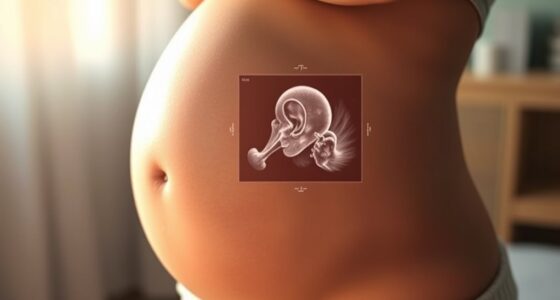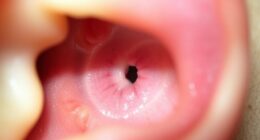Standard audiograms often miss hidden hearing loss caused by neural damage, so you might pass tests despite struggles in noisy places or fatigue after listening. Advanced tools like electrophysiological tests, ABR, and OAEs can detect synaptic and neural issues invisible on regular exams. Recognizing symptoms like difficulty understanding speech in crowds or tinnitus is key. To learn more about how innovations are transforming diagnosis and treatment, keep exploring these new developments.
Key Takeaways
- Standard audiograms only measure hearing thresholds to specific tones, missing neural damage or synaptopathy.
- Electrophysiological tests like ABR and OAEs can reveal hidden hearing loss not detected by traditional audiograms.
- Symptoms such as difficulty understanding speech in noisy environments indicate underlying neural processing issues.
- Advanced diagnostics target cochlear nerve health and synaptic integrity to identify auditory damage invisible to standard tests.
- Emerging treatments focus on neural repair and regeneration, emphasizing early detection through sensitive diagnostic tools.
Understanding the Limitations of Standard Audiograms
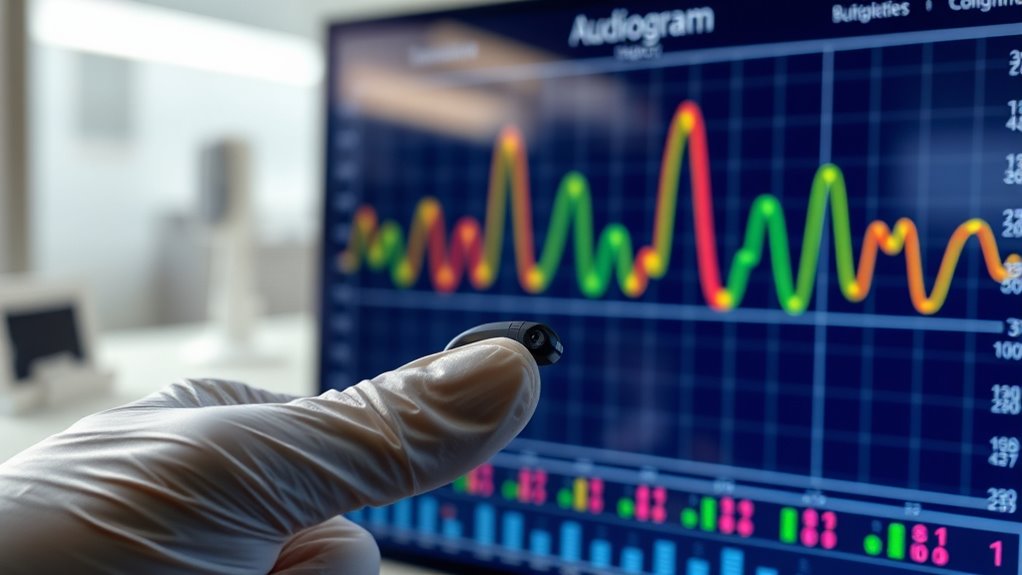
Standard audiograms are the most common method used to assess hearing loss, but they have notable limitations. They primarily measure your ability to hear specific tones at certain volumes, often missing subtle issues caused by noise exposure or auditory fatigue. If you’ve experienced prolonged exposure to loud environments, your hearing might seem fine in a quiet test, yet still be compromised. This is because audiograms don’t evaluate how noise exposure affects your auditory system over time. Similarly, auditory fatigue from listening to loud sounds can temporarily impair hearing, which standard tests may not detect. As a result, audiograms might underestimate your hearing difficulties, especially in noisy settings or during extended listening. Recognizing these limitations is essential for understanding what traditional tests might overlook. Understanding auditory health can provide deeper insight into hidden hearing issues that standard audiograms may miss.
The Science Behind Hidden Hearing Loss

Have you ever wondered how someone can pass a hearing test yet still struggle to understand speech in noisy environments? Hidden hearing loss results from neural degradation, especially cochlear synaptopathy, where connections between hair cells and auditory nerve fibers weaken. This damage doesn’t show up on standard audiograms but impairs your ability to process complex sounds. Fundamentally, despite normal hearing thresholds, your brain receives less accurate signals, making it hard to distinguish speech amid background noise. Understanding this science helps explain why some people experience difficulties without obvious hearing loss. Here’s a quick overview:
| Cause | Effect |
|---|---|
| Cochlear synaptopathy | Reduced neural signals to the brain |
| Neural degradation | Poor sound clarity in noisy settings |
| Hidden damage | Normal audiograms, impaired hearing ability |
Additional research highlights the importance of comprehensive assessments to detect hidden hearing loss that traditional tests may overlook.
Symptoms That Signal Hidden Hearing Issues
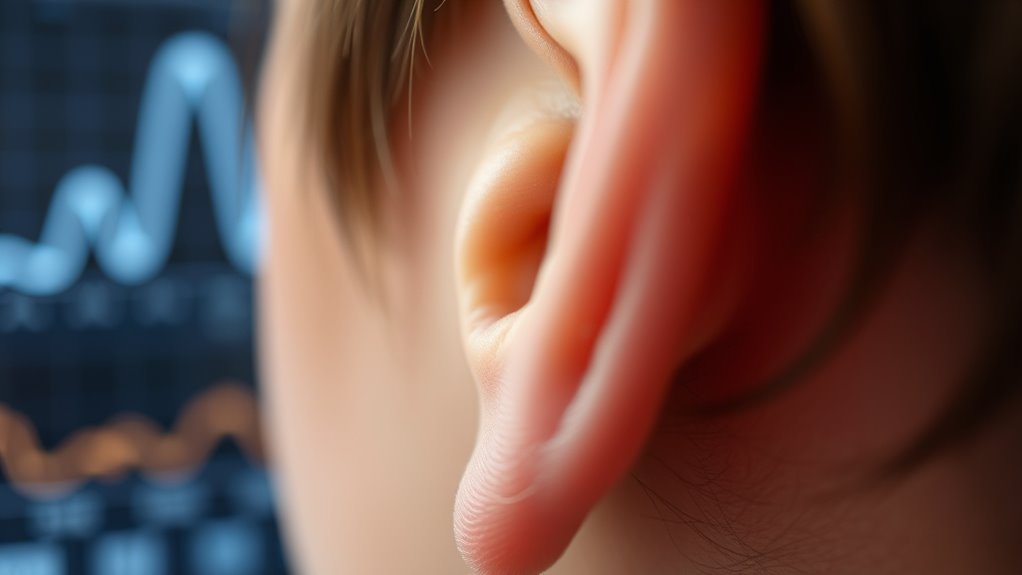
Even if your hearing tests come back normal, you might notice you’re having trouble understanding speech in noisy places. This difficulty can be a sign of hidden hearing issues. You may also experience tinnitus perception, where ringing or buzzing persists even with normal audiograms. These symptoms often indicate that your auditory system isn’t processing sounds properly. Additionally, some seniors find that humor in texting or playful communication can serve as a digital literacy tool to stay connected and engaged. Look out for: – Struggling to follow conversations in crowded settings – Increased effort to understand speech – Persistent tinnitus perception without obvious hearing loss These signs suggest your hearing challenges aren’t visible on standard tests but still impact your daily life. Recognizing them early can help you seek targeted solutions and better understand your hearing health.
Advanced Diagnostic Tools for Hidden Hearing Loss
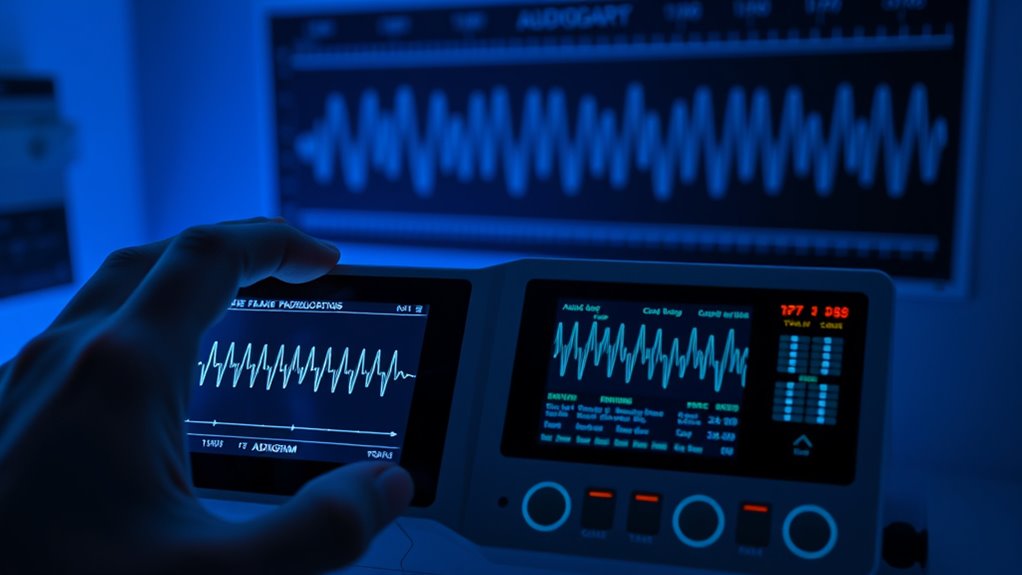
Advanced diagnostic tools like electrophysiological testing help uncover hidden hearing issues that standard tests might miss. Techniques such as Auditory Brainstem Response (ABR) and Otoacoustic Emissions (OAEs) provide detailed insights into your auditory system’s function. Using these tools, audiologists can identify subtle nerve and cochlear problems often associated with hidden hearing loss. Understanding Honda Tuning concepts can also help in optimizing hearing aid performance for affected individuals.
Electrophysiological Testing Techniques
Electrophysiological testing techniques have become essential in diagnosing hidden hearing loss, as they provide objective measures of auditory nerve and brainstem function that standard audiograms often miss. These tests assess the health of neural pathways and cochlear synapses, revealing damage not visible through traditional hearing tests. They help identify subtle deficits by recording electrical responses generated by the auditory system in response to sound stimuli. Additionally, advancements in automation and diagnostic tools are improving the accuracy and accessibility of these assessments.
Auditory Brainstem Response (ABR)
Auditory Brainstem Response (ABR) testing serves as a crucial tool in diagnosing hidden hearing loss by measuring the electrical activity in your auditory nerve and neural pathways in response to sound stimuli. During the test, electrodes are placed on your scalp and near your ears to record how your auditory nerve transmits signals from the cochlea to your brainstem. This assessment helps identify abnormalities in neural conduction that may not show up on standard audiograms. ABR provides objective data on the timing and strength of neural responses, revealing issues with neural pathways that could underlie difficulty understanding speech in noisy environments. By focusing on the integrity of your auditory nerve and neural pathways, ABR offers a deeper insight into hidden hearing issues often missed by conventional hearing tests. Additionally, understanding and addressing AI vulnerabilities in diagnostic tools ensures the reliability and safety of advanced hearing assessments.
Otoacoustic Emissions (OAEs)
Otoacoustic emissions (OAEs) are sounds that your inner ear generates in response to auditory stimuli, offering a direct window into cochlear health. These tiny sounds, produced by outer hair cells, can be measured with a sensitive microphone placed in your ear canal. OAEs are useful because they can detect cochlear damage even when standard hearing tests appear normal. When otoacoustic emissions are present, your cochlear health is likely intact; if absent, it may indicate hidden damage. This makes OAEs a valuable tool for early diagnosis.
- Detect subtle cochlear damage before it affects hearing
- Differentiate between sensory and neural hearing issues
- Monitor ear health over time for early intervention
The Role of Synaptic Damage in Auditory Dysfunction

Although traditional hearing tests often appear normal, synaptic damage between hair cells and the auditory nerve can still impair your ability to hear clearly. This damage, called synaptic damage, disrupts the connection between hair cells in your cochlea and the auditory nerve fibers that carry sound signals to your brain. Even if your audiogram looks normal, you might struggle with understanding speech in noisy environments or experience muffled sounds. Synaptic damage doesn’t necessarily affect your hearing thresholds but hampers how well your brain processes complex sounds. This hidden loss of synapses means that your auditory nerve’s ability to transmit accurate signals is compromised, leading to difficulties in real-world listening that standard tests often fail to detect. Additionally, meditation and mindfulness practices may help improve auditory processing by reducing stress and promoting neural resilience.
Emerging Treatments and Management Strategies

Recent advances in research have led to promising treatments and management strategies aimed at addressing hidden hearing loss. Researchers are exploring options like gene therapy to repair damaged synapses and pharmacological interventions to protect or restore auditory nerve function. These emerging approaches aim to target the root causes rather than just symptoms. Additionally, ongoing studies are investigating collagen and hyaluronic acid as potential agents to support nerve health and regeneration. Key strategies include:
- Developing gene therapy techniques to regenerate synapses
- Using drugs to prevent or reverse nerve damage
- Combining therapies for more effective results
While still in experimental stages, these innovations offer hope for better diagnosis and treatment. As research progresses, you may soon have access to personalized, targeted options that go beyond traditional hearing aids, directly addressing the underlying neural damage of hidden hearing loss.
The Impact of Hidden Hearing Loss on Daily Life

Hidden hearing loss can substantially affect your daily interactions, even if standard hearing tests show normal results. You might find it difficult to follow conversations in noisy environments or enjoy music as you used to, since your ability to perceive subtle sounds is impaired. This can lead to misunderstandings or feelings of isolation, especially during social gatherings. You may also struggle to pick up on emotional cues or background sounds that help you connect with others. Over time, this unnoticed hearing difficulty can impact your social communication and overall quality of life. Although your audiogram appears normal, these challenges highlight how hidden hearing loss can subtly disrupt your everyday experiences, making it harder to stay engaged and connected with those around you. Advances in hearing assessment techniques are helping to identify these issues more accurately.
Future Directions in Hearing Loss Research

Future directions in hearing loss research are focusing on developing more sensitive diagnostic tools and targeted treatments that address the limitations of traditional audiometry. Researchers aim to better understand how genetic factors and environmental influences contribute to hidden hearing loss. Advances may include tests that detect synaptopathy or neural damage not visible on standard audiograms. To improve outcomes, efforts are being made to:
- Identify genetic markers linked to susceptibility
- Assess environmental impacts like noise exposure more accurately
- Develop personalized therapies based on individual risk profiles
- Incorporate air quality considerations to better understand environmental influences on auditory health.
Frequently Asked Questions
Can Hidden Hearing Loss Affect Tinnitus or Balance Issues?
Hidden hearing loss can indeed affect tinnitus and balance issues. You might notice ringing or difficulty in noisy environments due to auditory processing problems caused by cochlear synaptopathy. This condition damages the connections between hair cells and auditory nerve fibers, which audiograms often miss. As a result, your brain struggles to interpret sounds correctly, leading to tinnitus or balance disturbances even when standard hearing tests show normal results.
How Early Can Hidden Hearing Loss Be Detected?
Imagine your ears as silent sentinels guarding your hearing. Early detection of hidden hearing loss is like finding a faint whisper before it becomes a roar. Advanced diagnostic methods, such as speech-in-noise tests and auditory brainstem responses, help reveal this concealed damage. You can catch it early, often before audiograms show any signs, giving you a chance to protect your hearing and address issues proactively.
Are Certain Populations More Prone to Hidden Hearing Loss?
Certain populations are more prone to hidden hearing loss, especially those exposed to occupational noise or with genetic predispositions. If you work in noisy environments, you’re at higher risk because standard audiograms might not detect early damage. Likewise, genetic factors can make some individuals more vulnerable. Staying aware of these risks helps you seek early testing and protective measures, preventing further hearing issues that typical assessments might miss.
What Lifestyle Factors Contribute to Hidden Hearing Damage?
Imagine you’re back in a jazz age speakeasy, unaware of the silent damage happening. Your lifestyle choices matter—excessive noise exposure from concerts or loud workplaces can cause hidden hearing damage. Using ototoxic medications regularly also harms your inner ear’s delicate structures. Protect your hearing by limiting loud environments and consulting your doctor about medication risks. Small changes today can prevent unseen hearing loss tomorrow.
Is Hidden Hearing Loss Reversible With Current Treatments?
You might wonder if hidden hearing loss is reversible with current treatment. Currently, the reversibility potential remains limited because it often involves nerve damage that’s hard to repair. While some approaches, like auditory training or hearing aids, can help improve hearing experiences, they don’t fully reverse the underlying damage. Researchers continue exploring new treatments, but at this point, most interventions focus on managing symptoms rather than reversing the condition itself.
Conclusion
You might be surprised to learn that up to 40% of hearing damage goes undetected by standard audiograms. Hidden hearing loss can quietly affect your ability to understand speech in noisy environments, even if your ears seem fine. By staying aware of symptoms and exploring advanced diagnostic options, you can catch issues early. Staying informed and proactive helps protect your hearing health, ensuring you don’t miss out on life’s important moments due to unseen auditory damage.





